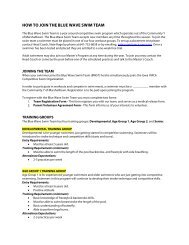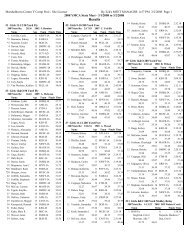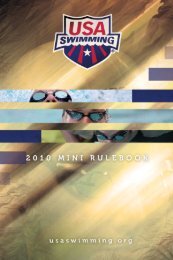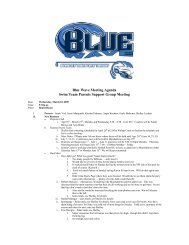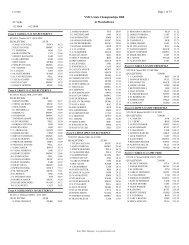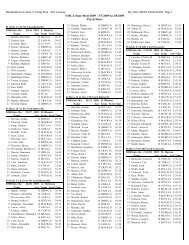Fly-Over Start Education - Blue Wave Swim Team
Fly-Over Start Education - Blue Wave Swim Team
Fly-Over Start Education - Blue Wave Swim Team
Create successful ePaper yourself
Turn your PDF publications into a flip-book with our unique Google optimized e-Paper software.
Protocol for <strong>Fly</strong>-over <strong>Start</strong>s<br />
Iowa YMCA <strong>Swim</strong>ming is adopting the use of fly-over starts at the 2013 Sectional and State swim meets.<br />
A fly-over start is a forward start where a heat is started while the previous heat’s swimmers remain in<br />
the water at the conclusion of the race.<br />
This type of start offers meet management a tool to help manage session time lines. For swimmers, flyover<br />
starts provides the benefit of allowing in water swimmers a moment to catch their breath before<br />
having to exit the pool and allow more time for the next heat of swimmers to assume their start<br />
positions without holding up the pace (time line) of the meet. By adopting fly-over starts, Iowa YMCA<br />
swimmers will be accustomed to these types of starts, which are sometimes used in other types of<br />
meets such as Regionals, Zones and Nationals.<br />
Situations where fly-over starts shall not be used<br />
Backstroke and Relay (Medley and Freestyle) starts<br />
<strong>Fly</strong>-over starts should be avoided for the first heat involving forward starts in individual events that<br />
follow immediately after either backstroke or relay events. Those swimmers probably do not realize a<br />
transition is about to occur and will expect to climb out of the water.<br />
<strong>Fly</strong>-over <strong>Start</strong> protocol:<br />
After the last swimmer in the heat passes the 15y mark from the start/finish end, the Referee will sound<br />
the four or five short whistle chirps. Depending on the pace of the race, the Referee should adjust the<br />
timing of the “four or five whistle chirps” for purposes of consistency; such that there is a 10 to 15<br />
second gap between the “four or five whistle chirps” and the “long whistle”<br />
The announcer/starter will announce the heat number/long event name.<br />
As the last swimmer passes under the flags closest to the finish the referee sounds the long whistle for<br />
the swimmers to step on the blocks.<br />
All swimmers at the conclusion of their race shall move to the corner of the lane and remain stationary<br />
until after the next heat has started. While waiting in the water, swimmers should please remain as still<br />
as possible with legs hanging straight down and shall not hold onto the starting blocks or talk.<br />
When the swimmers on the starting blocks are in place, the Referee turns the heat over to the <strong>Start</strong>er by<br />
extending his/her arm to the <strong>Start</strong>er.<br />
When the swimmers on the starting blocks are ready the <strong>Start</strong>er issues the “Take Your Mark” command,<br />
and when appropriate gives the start signal.<br />
After the start of the race, the in-water swimmers shall quickly exit the pool as directed by the starter.
Guidance to officials:<br />
The use of fly-over starts does not change our current practice of requiring swimmers to exit the pool<br />
prior to starts of backstroke or relay races.<br />
Set timing console parameter “Pad delay at start” to at least 15 seconds. The Referee shall review timing<br />
console parameters to ensure correct settings for fly-over starts.<br />
If there is significant delay--equipment malfunction, seeding confusion, resolution of a disqualification,<br />
etc. in starting the next heat, the <strong>Start</strong>er may request the in-water swimmers to exit the pool.<br />
Dive-over starts may be used when a swimmer wishes to start from the deck at the side of the starting<br />
block. In this situation, the swimmer in the water and the swimmer starting on the deck should be on<br />
opposite sides of the lane.<br />
If a swimmer wishes to start in the water for a forward start, the previous heat should be asked to exit<br />
to the pool prior to the start.<br />
Summary of Responsibilities:<br />
The following are additional responsibilities for the various roles in support of fly-over starts.<br />
Meet Referee: In conjunction with the Meet Director, determine the parameters for using fly-over<br />
starts.<br />
Deck Referee: Determine pacing of whistle chirps, ensure compliance of the above procedures.<br />
For safety reasons or special situations, such as swimmers with disabilities (physical or visual), fly-over<br />
starts may be deferred for any heat. While adopting fly-over starts is to help reduce the session time<br />
line, the Deck Referee needs to understand that the time line is only one consideration for determining<br />
the pace of the session. The Deck Referee’s first responsibility is to the swimmers and to ensure a fair<br />
and equitable competition as possible.<br />
<strong>Start</strong>er: Brief timers on the timing protocol for fly-over starts. Ensure in-water swimmers are stationary<br />
at a corner of the lane, not holding onto the starting block and quiet. If necessary, use minimal verbal<br />
commands to request in-water swimmers to adhere to the guidelines described in this document. Notify<br />
Deck Referee of any unusual situations that may delay the next heat. This will avoid the situation of<br />
calling the swimmers to the blocks too early.<br />
Timing System Operator: Ensure timing system parameters allow at least a 15 second delay at the start<br />
but not too long as to miss the first pad touch after the start. Observe swimmers exiting the pool after<br />
the start and be prepared to take away a pad touch if needed.<br />
Coaches: Instruct swimmers on the dive-over protocol and practice this during the regular season. Prior<br />
to the start of a meet session notify the Iowa YMCA Executive Committee of any circumstances that may<br />
affect the use of fly-over starts, such as swimmers with disabilities or if a swimmer will start from the<br />
deck or in-water for forward starts.
Timer procedure to support fly-over starts:<br />
Depending on the number of watches available, one of the following procedures should be used. The<br />
following assumes timing pad in water and two buttons.<br />
One, two or three timers each with two watches per timer:<br />
Each timer has two watches, which are worn around the neck by a lanyard.<br />
At the start of a race, timer starts a watch (Watch A) and ensures the watch is operating correctly.<br />
At the conclusion of the race, timer simultaneously stops Watch A and presses the button.<br />
Without clearing Watch A, timer allows Watch A to hang from the lanyard for the moment and picks up<br />
Watch B in preparation for the start of the next heat.<br />
After starting Watch B for the next heat and ensuring Watch B started successfully, timer allows Watch<br />
B to hang from the lanyard and picks up Watch A to record the time for the previous heat on the Lane<br />
Timer sheet. After recording the time, the timer clear Watch A in preparation for the next race and<br />
times the current heat with Watch B.<br />
This process is repeated alternating Watch B and A as appropriate.<br />
Two Timers each with one watch.<br />
Timer A starts his/her watch at the start of the race.<br />
At the end of the race, Timer A simultaneously stops the watch and presses the button,<br />
Timer B presses a button.<br />
Timer A records the single watch time while Timer B prepares to start his/her watch for the next heat.<br />
The two timers alternate using their respective watches to record a single watch time for each heat.<br />
Two Timers, one person with a watch and the other for recording watch time.<br />
One person times the race with the watch, other person writes down the time<br />
Both persons press the button at the conclusion of the race.



